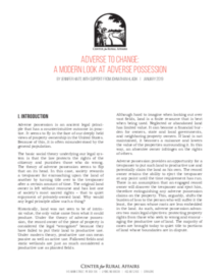The basic social theory underlying our legal system is that the law protects the rights of the citizenry and punishes those who do wrong. The theory of adverse possession seems to flip that on its head. In this case, society rewards a trespasser for encroaching upon the land of another by turning title over to the trespasser after a certain amount of time. The original land owner is left without recourse and has lost one of society’s most sacred rights – that to quiet enjoyment of privately-owned land. Why would any legal principle allow such a thing?
Historically, land was not seen to be of intrinsic value, the only value came from what it could produce. Under the theory of adverse possession, the record owner of the piece of property is considered the legal “wrongdoer” because they have failed to put their land to productive use. Under modern theory, productive use can mean passive as well as active use. Fallowed fields and static wetlands are just as much considered a productive use as planted fields.
Although hard to imagine when looking out over vast fields, land is a finite resource that is best when being used. Neglected or abandoned land has limited value. It can become a financial burden for owners, state and local governments, and neighboring property owners. If land is not maintained, it becomes a nuisance and lowers the value of the properties surrounding it. In this way, an absentee owner infringes on the rights of others.
Adverse possession provides an opportunity for a trespasser to put such land to productive use and potentially claim the land as his own. The record owner retains the ability to eject the trespasser at any point until the time requirement has run. There is an assumption that an engaged record owner will discover the trespasser and eject him, therefore extinguishing any adverse possession claims on the property. This, arguably, shifts the burden of loss to the person who will suffer it the least, the person whose roots are less embedded in the land. As such, adverse possession advances two main legal objectives: protecting property rights from those who seek to wrong and encouraging the productive use of land. The majority of cases are brought today to quiet title to portions of land whose boundaries are in dispute.
This report is written by Jennifer Hiatt, consultant, with support from Johnathan Hladik, Policy Program director.


